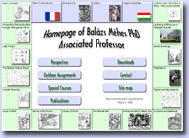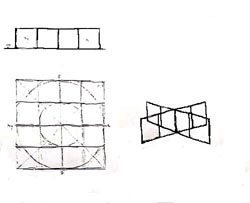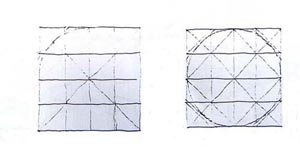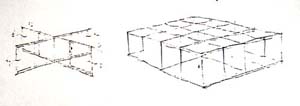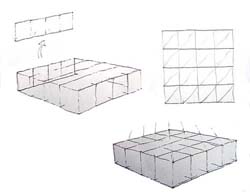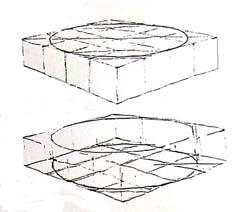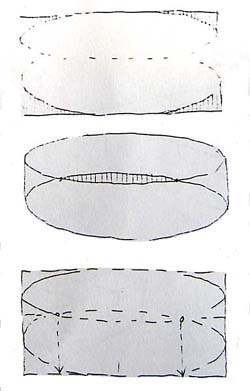|
| |
Illustrated Construction of
CIRCULAR RINGS
by Freehand |
|
| |
Key-words: "compass-ladder", circle construction backed by eights points' tangents, cross of axes, framework intersection, framing shape, orthogonal pictures, overlapping, picture plane mosaic, principal direction, quadratic ribbing, Simple Geometrical Shapes (as regular triangles and quadrangles with a pair of parallel sides), structural grid of basic lines. |
|
|
1. Structural grid
While analyzing our orthogonal pictures belonging to the set we should interpret distances born between quadratic planes as well. It is advisable to orientate according to points of compass. Thus we may discuss axes of north-south or east-west. On top view the structural grid composed of small cubes is perfectly visible. The set's ribbing here is made of vertical squares. With the help of diagonals let's thorough fully control the quadratic net of 4 x 4! |
|
|
2. Circle construction
First we deploy circle construction within the top view - assembling a circle of fragments forming eights-curves. |
|
|
|
|
3. Analysis of "compass-ladders"
Let's observe compass-ladders one by one and compared to each other as well! We should depict carefully overlapping areas seen from our view-point. Don't forget that parts of the full framing shape are made of neighboring wings plus areas of negative shape! |
|
|
|
4. Comparison of adjacent "compass-ladders"
|
We compress "compass-ladders" (regarding them as picture plane mosaics) between principal directions. Head- and bottom lines put on highest and lowest points of enveloping contour line represent mosaic's utmost limits.
|
|
5. Intersection, overlapping, picture plane mosaic
Here we analyze intersections of compass-ladders. We put principal directions on utmost points and carefully control complementary negative shapes as well. This stage helps us to determine final relation between main dimensions called total height and total largeness. |
|
|
We dissolve picture plane mosaics into Simple Geometrical Shapes. Observing frames' intersection runs e.g. murmuring like this: "Northern frame's left border intersects western frame's top by its third. Three fourth of northern frame's bottom intersects western frame's right half ." etc. We watchfully observe overlapping areas (this means proportion measuring of interim patches). |
|
|
6. Finishing of "compass-ladders"
Here we see a system of full and empty squares in diagonal position. We try to complete "compass-ladders" to a full cubic grid of 4 x 4. |
|
|
7. Controls
After having controlled the backward ladder's quadratic row we complete the upper quadratic net. Real diagonals being parallel they seem to converge in perspective as well. |
|
|
|
|
8. Ellipsoids
The structural grid of full circular ring consists of sixteen small cubes. To find the bottom ellipsoid it is enough to look for some minimal linear fragments, because extreme tangents are already known! |
|
|
9. Observations
Most important stage of observations carried out simultaneously with constructions is maybe to determine the proportion of framing shape at the beginning of process. Often curves are overlapping (here interim patch is toned), their relation should be observed very carefully. Finally it is advisable to project curves' eventual intersections up and down to enveloping contour frame. |
|
|
|
Summary |
|
The structural grid of complete circular ring presented here is composed of sixteen small cubes. An essential stage of observation carried out simultaneously with construction is to determine the framing shape's proportion and to settle the accurate relation between curves.
The ribbing is made of real and virtual squares called (for the sake of better orientation) "compass-ladders" or "frames". Observing their relation compared to each other seems to be the key to circular ring's structure. |
|
|
| |
|
| |
![]() © All rights reserved Associated Professor Balazs Mehes PhD
© All rights reserved Associated Professor Balazs Mehes PhD
recommended resolution 1024×768
|
